Land Rover series 2 2A 3 workshop repair manual
The land-rover show we, II, and III tend to be off-road cars generated by the Uk manufacturer land-rover that were motivated by the US-built Willys Jeep.
Show designs showcase leaf-sprung suspension with selectable two or four-wheel drive; although the phase 1
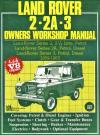
Get other Land Rover repair manuals hereRe-issue of Autobooks manual covering all tasks and components for the following: Series 2 2.25 litre Petrol 1959 - 1961. Series 2A Petrol and Diesel 1961 - 1971. Series 3 Petrol and Diesel 1971 - 1983.Land Rover Series 2/2A/3 1959 - 1983 Manual Covers all 4 6 and V8 engines 1959 - 1983Contents: The Petrol Engine. The Diesel Engine. The Petrol Fuel System - Solex Zenith Stromberg and SU Carburetters (Carburettors). The Diesel Fuel System. The Ignition System. The Cooling System. The Clutch. The Gearbox and Transfer Gearbox. Propeller Shaft Rear Axle and Rear Suspension. Front Suspension Differential and Hubs. The Steering Gear. The Braking System. The Electrical Equipment. The Bodywork. Optional Equipment. Technical Data. Wiring Diagram 2.25 Litre Petrol Models Series 2 - Positive Earth. Wiring
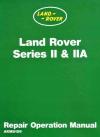
Get other Land Rover repair manuals hereLand Rover Series 2 2A Repair Operation Manual previously issued in separate parts now combined in one comprehensive manual.Covers All Series 2 2A 2.25 litre 2.6 litre Petrol and 2.25 litre Diesel Engines - Clutch - Gearbox - Transfer BoxContents: Engine - 2.25 litre 4 Cylinder Petrol. Engine - 2.25 litre 4 Cylinder Diesel. Engine - 2.6 Litre 6 Cylinder Petrol. Clutch Units. Gearbox. Propellor Shafts. Rear Axle Suspension. Front Axle Suspension. Steering Linkage. Brake System. Chassis. Cooling System. Fuel System. Exhaust System. Electrical Equipment. Circuit Diagram 2.25 Litre Petrol Models Series 2 Positive Earth Circuit Diagram 2.25 Litre Petrol Models Series 2A Positive Earth Circuit Diagram 2.25 Diesel Models Series 2A Positive Earth Circuit Diagram Regular and Long Diesel Models Series 2A with combined electrical services starter and heater plug switch positive Earth Circuit Diagram Forward Control Petrol Models Series 2A Positive Earth Circuit Diagram North American Dollar Area 2.6 L
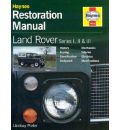
Land Rover Series I II and III Restoration Manual by Lindsay PorterGet other Land Rover repair manuals hereThe Land-Rover was the first British four-wheel-drive vehicle of its type. Having enjoyed world-wide success with numerous models variants and modifications this book takes the reader through the acquisition and restoration of a typical Land-Rover with detailed descriptions and illustrations of the processes needed to thoroughly renovate and improve the vehicle. The book includes tips on what to look for when buying this type of vehicle how to renovate bodywork and chassis how to strip out and replace interiors and how to overhaul engine electrical components and suspension systems. Integracar tries to provide you with a diverse diversity of service guides. But yet owners manuals could well be released for multiple countries and the automobiles built for those countries. So not all maintenance manuals may be best for your selected automobile. If you have a
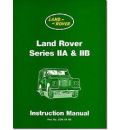
Land Rover Series IIA and IIB Instruction Manual by Brooklands Books LtdGet other Land Rover repair manuals hereCovers long and short wheelbase and forward control models. A4 format.
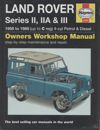
Land Rover Series 2 2A and 3 1958 to 1985 Petrol and Diesel Haynes Service and Repair Manual NEW hardback 150 pages Other Land Rover Service and Repair Manuals click here Land Rover Series 2 2A 3 Petrol 1958 - 1985 Haynes Owners Service Repair Manual Covers: Series 2 2A and 3 (Including County) with 88 and 109-inch wheelbase 1958 - 1985. 2 1/4 litre (2286cc) 4 Cylinder Petrol.2.25 litra (2286) 4-cylinder Diesel Does NOT cover 6 Cylinder or V8 engines. 24V electrical systems or forward control models.Inside this manual you will find: Routine Maintenance tune-up procedures engine repair cooling and heating air-conditioning fuel and exhaust emissions control ignition brakes suspension and steering electrical systems and wiring diagrams.
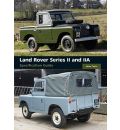
Land Rover Series II and IIA Specification Guide by James TaylorGet other Land Rover repair manuals hereThe Series II [1958-61] and Series IIA [1961-71] Land Rovers defined the iconic shape of the vehicle which is still instantly recognizable in today s utility models from Land Rover. Compiled over nearly thirty years with the aid of reference material produced by Land Rover and many dedicated enthusiasts this comprehensive guide to the specifications of the Series II and IIA vehicles looks not only at Land Rovers as they were when they left the assembly lines but also at dozens of options and approved special conversions - and some which did not receive factory approval too.Land Rover Series II and IIA Specification Guide by James Taylor
Show designs showcase leaf-sprung suspension with selectable two or four-wheel drive; although the phase 1 V8 version of the Series III featured permanent 4WD. All three systems could possibly be began with a front hand crank along with a choice of a rear energy takeoff for add-ons.
The Land Rover ended up being conceived by the Rover Company in 1947 during aftermath of globe War II. Ahead of the war Rover had produced luxury automobiles which were maybe not popular into the instant post-war period and raw materials were purely rationed to those businesses design construction or manufacturing products, or products which could possibly be widely exported to earn important currency exchange the country. Additionally, Rover's initial factory in Coventry was indeed bombed through the war, forcing the organization to maneuver into a huge "shadow factory" built prior to the war in Solihull near Birmingham, and accustomed build Bristol Hercules aircraft engines. This factory was now empty but beginning vehicles manufacturing here from scrape would not be economically viable. Methods for a little, economical vehicles referred to as M Type were used, and a few prototypes made, but is too expensive to make.
Maurice Wilks, Rover's chief fashion designer came up with a strategy to make a light farming and utility car, of a similar concept towards the Willys Jeep found in the war, however with an emphasis on farming usage. He was perhaps encouraged because of the traditional Motor Company, whom encountered similar trouble and are making the highly effective Ferguson TE20 tractor in their shadow factory in Coventry. Much more likely, he put their own experience of using an army-surplus Jeep on his farm in Anglesey, North Wales. His design added a power take-off feature since there was a gap in the market between jeeps and tractors. The original land-rover concept is comparable to the Unimog, which was developed in Germany in those times.
The initial model have a unique feature â the controls had been attached in the middle of the car. They ergo became known as the "centre steer". It absolutely was built on a Jeep framework and made use of the motor and gearbox from a Rover P3 saloon automobile. The bodywork was handmade away from an aluminium/magnesium alloy labeled as Birmabright, to truly save on metallic, that has been closely rationed. The choice of color was dictated by armed forces surplus supplies of aircraft cockpit paint, therefore early motors only arrived in several colors of light-green. The very first pre-production Land Rovers were being created in late 1947 by a group led by professional Arthur Goddard.
Examinations revealed this model car is a capable and functional device. The PTO drives from front for the system and from gearbox toward centre and backside regarding the car permitted it to push farm equipment, exactly as a tractor would. It absolutely was also tested ploughing and carrying out various other farming work. However, because the vehicle is readied for production, this increased exposure of tractor-like use reduced while the centre steering proved not practical used. The steering wheel was installed to the medial side as normal, the bodywork was simplified to lessen manufacturing time and prices and a bigger engine was installed, along with a specially designed transfer gearbox to displace the Jeep product. The result was an automobile that don't use a single Jeep component and is a little shorter than its American motivation, but broader, heavier, faster but still retained the PTO drives.
The Land Rover was designed to simply be in production for 2 or three years to get some dough circulation and export purchases for the Rover team so that it could restart up-market car production. Once automobile production restarted, but was greatly outsold because of the off-road Land Rover, which progressed into a unique brand that continues to be successful these days. A number of the determining and effective features of the Land Rover build are in reality the consequence of Rover's drive to streamline the tooling required for the car also to make use of the minimum quantity of rationed content. As well as the aluminum alloy bodywork other for example the unique level human anatomy panels with best easy, constant-radius curves additionally the durable box-section ladder framework, which on show cars ended up being composed from four pieces of steel welded at each side to form a box, hence reducing the complex welding functions needed when creating an even more conventional U- or I-section framework.
Land Rover registered production in 1948 in what ended up being later on called the show we. This is established within Amsterdam Motor program. It was initially made for farm and light industrial use, together with a steel box-section framework, and an aluminum body.
Originally the Land Rover is just one model offering, which from 1948 until 1951 put an 80-inch wheelbase and a 1.6-litre petrol engine making around 50 bhp. The four-speed gearbox from Rover P3 is utilized, with a new two-speed transfer box. This included a silly four-wheel-drive system, with a freewheel product. This disengaged leading axle from the handbook transmission on the overrun, permitting a kind of permanent 4WD. A ring-pull mechanism inside driver's footwell permitted the freewheel is locked to present more traditional 4WD. This is a basic vehicle: tops when it comes to doorways and a roof had been optional extras. In 1950, the lighting moved from a posture behind the grille to protruding through the grille.
Right from the start it absolutely was realised that some purchasers would want a Land Rover's capabilities minus the spartan interiors. In 1949, land-rover launched a moment system alternative called the "place Wagon", fitted with a body built by Tickford, a coachbuilder recognized for their utilize Rolls-Royce and Lagonda. The bodywork ended up being wooden-framed together with seating for seven staff. Tickford ended up being well equipped when compared with the conventional land-rover, creating fabric seating, a heater, a one-piece laminated windscreen, a tin-plate spare wheel cover, some inside trim alongside choices. The wood construction made them expensive to build. The Tickford ended up being taxed as a personal automobile, which drawn large degrees of Purchase Tax unlike the initial land-rover. Thus, under 700 Tickfords had been offered, and all but 50 are shipped.
In 1952 and 1953, a larger 2.0-litre petrol system ended up being fitted. This system has Siamese bores, and therefore there are not any water passages for air conditioning involving the cylinders. During 1950, the unusual semi-permanent 4WD program ended up being changed with an even more traditional setup, with drive to the front side axle being taken through a straightforward puppy clutch. For this time the land-rover's legal condition has also been clarified. As mentioned above, the Land Rover is originally classed as a commercial car, meaning it absolutely was clear of buy income tax. But this also required it absolutely was limited by a speed of 30 mph on British roads. After an appeal into Law Lords after an owner had been charged with exceeding this limit, the Land Rover had been categorized as a "multi-purpose car" which was simply to feel classed as a commercial car if useful for commercial reasons.
The 1954 model year brought significant adjustment. The 80-inch wheelbase design ended up being replaced by an 86-inch wheelbase design, and a 107-inch "get" variation ended up being launched. The extra wheelbase ended up being added behind the cab room to give further load area. In mid-1954 the "spread bore" petrol engine was introduced, permitting best air conditioning amongst the cylinders. This have been launched within the Rover automobile the entire year before. The engine was altered once more in 1955, often known as the 'later' spread bore.
1956 spotted the development of the initial five-door model, on the 107-inch chassis referred to as "facility truck" with seating for as much as ten group. The 86-inch model had been a three-door, seven-seater. This new station wagons had been different from the previous Tickford model, becoming built with quick metal panels and bolt-together construction rather than the complex wooden structure associated with older place Wagon. These were designed to be utilized both as commercial automobiles as people-carriers for carrying workmen to remote stores, plus by personal users. Like the Tickford variation, they came with fundamental internal trim and equipment such as roofing vents and interior lighting.
The Station Wagons spotted the first development of the Land Rover number. Section Wagons had been fitted with a "Safari Roof" which contained a second roof epidermis installed in addition to the automobile. This held the inner cool in warm weather and reduced condensation in winter. Ports fitted in the roofing let included air flow towards the inside. While they are based on the exact same chassis and drivetrains since the traditional cars, Station Wagons transported different chassis numbers, special badging, and had been marketed in individual literature. Unlike the first section truck, the brand new in-house versions had been very popular.
In mid-1956 the wheelbases are longer by 2 ins to 88 ins and 109 inches, plus the front framework cross-member ended up being moved an inches forward, to support the latest diesel motor, to be an alternative these year. This change was made to all models apart from the 107 section Wagon, which may not be fitted with a diesel engine, and would in the course of time end up being the last series I in manufacturing. These dimensions are to be utilized on all Land Rovers for the next 25 years.
In 1957 a whole new 2.0-litre diesel motor had been launched that, inspite of the close capability, wasn't related to the petrol machines used. The petrol motors of that time period put the rather out-dated inlet-over-exhaust device arrangement; the diesel put the more latest overhead valve design. This diesel engine was one of the first high-speed diesels created for path usage, making 52 hp at 4,000 rpm.
The successor on effective show I was the show II, which spotted a production run from 1958 to 1961. They arrived in 88 in and 109 in wheelbases. This was the very first land-rover to get the eye of Rover's styling department- Chief Stylist David Bache created the familiar 'barrel side' waist to cover the car's broader track as well as the enhanced design for the truck taxi variant, introducing the curved side house windows and rounded roof nevertheless utilized on current Land Rovers. The show II had been the initial car to make use of the well-known 2.25-litre petrol system, even though very first 1,500 roughly short wheelbase brands retained the 52 hp 2.0-litre petrol engine from Series we. This bigger petrol motor produced 72 hp and had been closely pertaining to the 2.0-litre diesel product nonetheless used. This motor became the typical Land Rover device before the mid-1980s when diesel motors became a lot more popular.
The 109-inch show II section truck launched a twelve-seater solution in addition to the standard ten-seater design. It was primarily to benefit from UNITED KINGDOM tax legislation, by which an automobile with 12 chairs or maybe more ended up being classed as a bus, and had been exempt from buy taxation and specialized automobile taxation. This made the twelve-seater not merely economical purchase than the 10-seater variation, but also cheaper than the seven-seater 88-inch place truck. The twelve-seater layout remained an extremely popular body style for many years, being retained from the subsequent show and Defender variants until 2002, when it was dropped. The strange reputation for the twelve-seater stayed before the endâsuch vehicles are classed as minibuses and therefore can use bus lanes and may be exempt through the London Congestion cost.
There clearly was some extent of over-lap between show we and show II production. Early show II 88-inch cars were fitted with the older 2-litre petrol engine to use up established stock from creation of the show I 107-inch facility truck continued until late 1959 because continued need from export areas also to permit the creation of Series II components to reach complete levels.
The SII and the SIIA have become hard to distinguish. There were some minor aesthetic modifications, nevertheless most crucial change ended up being underneath the bonnet in the guise of brand-new 2.25-litre diesel engine. Human body configurations available from the factory ranged from short-wheelbase soft-top on top-of-the-line five-door section wagon. In 1967 a 2.6-litre in-line six cylinder petrol engine was launched for long-wheelbase models which also has servo-assisted brakes. 811 of these were NADA trucks, that have been the actual only real long-wheelbase brands made for the American and Canadian areas.
From February 1969, the headlamps moved into the wings on all versions, and sill panels were redesigned becoming shallower a couple of months a short while later.
The Series IIA is regarded as by many the essential sturdy Series model constructed. It is also the type of classic Land Rover that has strongly inside public's perception of the Land Rover, from its many appearances in preferred films and tv documentaries set-in Africa through the entire 1960s, particularly delivered complimentary. In February 1968, just a couple of period as a result of its producer had been subsumed, under government stress, into the Leyland Motor business, the Land Rover celebrated its twentieth birthday, with complete production currently only lacking 600,000, which above 70% have been exported. Certainly it absolutely was as the show IIA was at manufacturing that business of utility Land Rovers reached their particular peak, in 1969â70, when sales of over 60,000 Land Rovers annually were recorded. Plus record product sales, the land-rover ruled most world areas- in Australia into the sixties land-rover presented 90% for the 4Ã4 markets. This figure had been recurring in a lot of region in Africa plus the center East.
The show III had similar human anatomy and motor alternatives while the preceding IIa, like facility wagons and also the 1 great deal variations. Little altered cosmetically from the IIA toward show III. The Series III is considered the most common Series vehicle, with 440,000 for the kind built from 1971 to 1985. The headlights were relocated to the wings on late manufacturing IIA systems from 1968/9 onward and stayed in this place when it comes to show III. The original metal grille, featured on Series we, II and IIA, had been replaced with a plastic one for show III model. The 2.25-litre system had their compression increased from 7:1 to 8:1, enhancing the energy a little. Throughout the Series III manufacturing run from 1971 until 1985, the 1,000,000th Land Rover rolled off the manufacturing range in 1976. The show III saw most alterations in the subsequent part of its lives as Land Rover updated the look to meet up increasing competition. It was initial design to function synchromesh on all four gears, though some late H-suffix SIIA systems had put the all-synchro box. Consistent with very early 1970s styles in automotive interior design, in both protection and use of more advanced content, the straightforward metal dashboard of prior designs had been redesigned to just accept an innovative new moulded plastic dash. The tool cluster, that was formerly situated, ended up being relocated to the driver's part. Long-wheelbase show III cars have the Salisbury backside axle as traditional, even though some belated SIIA 109-inch automobiles had them too.
In 1980, the 2.25-litre petrol and diesel machines got five primary bearing crankshafts to improve rigidity as well as the transmission, axles and wheel hubs had been enhanced. It was the culmination of a number of revisions to your transmission that were made because the 1960s to fight the all-too-common problem of a corner axle half-shafts breaking in heavy use. This issue is partially due to the design of this shafts themselves. Because of the fully drifting build associated with the rear wheel hubs, the 1 / 2 shafts are removed quickly without having to jack the vehicle from the floor. The inclination for commercial operators to overload their particular motors exacerbated this flaw which blighted the Series Land Rovers in a lot of of the export areas and set up a reputation that continues in a lot of areas for this time. This might be despite the 1982 re-design that but fixed the issue.
Furthermore, brand-new trim alternatives had been launched to really make the inside more comfortable if purchaser therefore wished.
These adjustment culminated in April 1982 using introduction associated with the "County" spec. Facility truck Land Rovers, obtainable in both 88-inch and 109-inch types. These had all-new fabric chairs through the Leyland T-45 Lorry, soundproofing kits, tinted glass as well as other "soft" alternatives designed to attract the leisure owner/user.
Of additional interest had been the introduction of the High Capacity grab toward 109-inch framework. This is a pick-up vehicle load bay that provided 25% more cubic ability than the standard pick-up style. The HCPU came with heavy-duty suspension and ended up being popular with public-utility companies and design technicians.
Australian continent has long been a significant export market for Land Rovers of various products, but particularly the utility systems. 80-inch Series I systems are offered on Australian national in the late 1940s for focus on municipal manufacturing work like dams and path construction, which brought the vehicle into purchasing public's interest. Big business adopted as well as in the 1950s Land Rover established factories in Australian Continent to construct CKD kits sent through the Solihull factory. The Land Rover continued to market well throughout the 1960s in show II guise, commanding some 90percent of off-road marketplace, along with practically every farm creating at least one Land Rover.
The Series III proceeded this profits during the early 1970s, but from the middle of ten years marketing declined. A big coal export price to Japan relied on the subsequent import of Japanese vehicles as well as other items, a variety of this increasing competitors and increasingly poor quality associated with the elements becoming shipped from Britain designed that Land Rover's prominence slipped. Problematic specific to Australian Continent is the always-limited way to obtain brand-new Land Rovers. Leyland's factory never had the capability to meet possible requirements in addition to have to import virtually the entire automobile in system kind from Britain limited the offer and manufacturing procedure more. This generated a long waiting checklist building when it comes to Leyland product whilst commercial providers could get big fleets of Japanese automobiles quickly. Another dilemmas encountered by-land Rover had been equivalent throughout their export markets- when compared to Japanese competitors, the Land Rover had been underpowered, unreliable and slow with a poor ride high quality, despite their particular superior off-road ability. Bad rust-proofing and low-quality metallic used in comparison towards Japanese cars switched the buyers away in large numbers by 1983, because of the introduction associated with the One Ten, the Toyota Land Cruiser became the best-selling 4Ã4 in Australian Continent.
During the early 1980s, Land Rover Australia had made some adjustment towards the automobile to try to fight this marketing decline. Along with the fitting of this V8 petrol motor in 1979 "level One", as in the rest of the world, Australian Continent additionally obtained similar automobile using choice of a 3.9-litre 97 hp four-cylinder Isuzu diesel system. This was launched in 1982, and ended up being meant to be furnished in about 10 percent associated with Australian manufacturing. Top speeds are 77 miles per hour. This aided slow the sales drop, nevertheless rest of the vehicle's shortcomings let it down. The One Ten was also available with this particular system, and a turbocharged version producing over 100 horse power operated the armed forces 6Ã6.
The Australian-made show 1, 2, 2A and 3 had been widely used by the Australian military, Royal Australian Navy and Royal Australian environment power. Many are GS mobility cars with alternatives built so long Range Patrol cars, ambulances, command reconnaissance vehicles, fire tenders and ceremonial automobiles.
1st had been delivered to the military in 1948 as well as the series 1 slowly replaced the planet War II period Austin Champs and Jeeps. The show 2 was launched in 1958, the 2a in 1963 and series 3 in 1973. 72 regarding the series 2 are fitted as an anti-tank "gunbuggy" with a 106mm recoilless rifle.
The land-rover Perentie, generally regarded as a military variation associated with the Land Rover Defender, was introduced in 1987, 3 years prior to the Defender was named in 1990. Over 2,500 four wheel drive and 400 six-wheel drive remain in service.
Series 2A Brake fix Thnaks to all for responding on the brakes. Just a note: After I depress the brakes the 1st time, the second time I press the brakes will almost make the LR skidd! I get really good brakes the second brake depression.
Land Rover Series I, II, IIA & III. Tires for my series 2a 88'' Collapse. X. ... 1967 SERIES 2A 88. Tags ...
fj rover I started my rebuild by putting fj55 (same as fj40) axles under my rover, but changed back when someone wanted to swap working rover axles for them. they had 4.10 gears. btw breakover year is mid 75 for "desireable"axles the rear spring perches need to come inboard about 1.5" each (puts one perch part way on pumpkin. fronts work as ...
The vehicle had been modified with Ford 302 to Series 2A tranny and 2A T-Case. I drove it shortly and it operated very well with no whine noise at highway speeds. The Fairey O.D. was designed for stock L.R. 4cyl. or 6cyl engines and is generally not recommended for modified V-8 hp and torque.
Members of the LR Series 2 club in the UK have access to many LR publications on its website including drivers Handbooks that have the wiring diagram. I have just looked and the 1971 Model Year NADA is listed but you need to be a member to view.
Speedometer cable install tip Series 2A 06-24-2021, 12:16 AM When replacing the speedometer cable in my 1970 Series 2A, I dutifully followed the Green Bibles instructions to remove the transmission tunnel (which makes you remove the floor first) to access the screws for the Speedo drive.
any positive displacement pump will get fuel out of the tank, it isn't that far away and the bottom of the tank is about even with the pump, Land rover pumps don't have to work very hard. I'm considering an electric model since the original Land rover pumps are hard to find and the rebuild kits available don't fit the original pump.
Land Rover Series I, II, IIA & III. Help with clutch - 1965 Series 2a ... Help with clutch - 1965 Series 2a
I have a 1966 Land Rovers Series 2A, with original 15 wheels. I need to upgrade all tires which are ancient. I have been advised to switch to 16" wheels as my original wheels need to be replaced. For tires, I would like chunkier mud tires, not because i plan to go overland, but rather i like the look of them. My questions. 1.
I think I have been just lucky on the pedal adjustment over the years but now that everything is spot on the little bit of clearance I had is gone. I believe that the small diameter driven disks will work for both ser 3 and 2A but not the other way around. This is potentially a problem as the same driven disk is listed for both a 2a and 3.